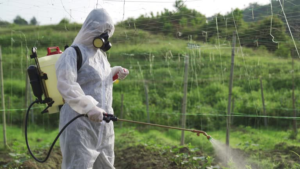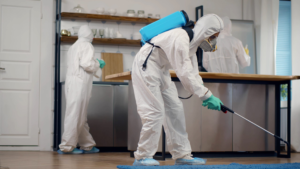Pest Control Maine involves managing the presence of various pests in order to minimise their impact on human health and hygiene. This is often accomplished by removing their food, water, or shelter. Store all foods in sealed containers, remove garbage regularly, fix leaky plumbing, and make sure there are no dark damp places that pests can hide.
The best way to deal with pests is to prevent them from occurring in the first place. Prevention strategies include early detection and routine property inspections. Structural preventive measures may also be employed to block pest access to food, water, shelter and entry points. These measures can include caulking openings, modifying the landscape to remove pest nesting sites, and maintaining good sanitation (e.g., removing trash regularly and knowing your local waste collection day).

Chemical preventive measures can also be effective. They may include sprays to control insects that feed on plants, odors to deter rodents, and traps to catch pests. The use of chemicals must be balanced with other methods to ensure that the environment remains healthy and safe. Whenever possible, a natural or biological control should be used in preference to a synthetic chemical. Chemicals should only be used when they are absolutely necessary and when other options are not feasible. When they are used, they should be carefully selected and applied to minimize the risk of exposure to people or pets.
If a pest infestation does occur, it is important to take prompt action. The objective is to reduce the number of pests to a level where their presence is acceptable, without causing unacceptable harm to people, pets or property. This is often referred to as “suppression.”
Once the pest problem has been controlled, it is important to monitor the situation to ensure that it does not return. The monitoring process may involve visual inspections, identifying signs of pest activity, and reporting findings to your pest control operator. In addition, it is important to keep in mind that some pests are seasonal and that a pest control program should be designed around the specific needs of the property, including the types of plants that are grown and the timing of their blooming.
When choosing a pest control operator, you should be sure to select one who is licensed, knowledgeable about the specific pests, and experienced in performing preventive treatments. In addition, a reputable pest control operator should belong to a professional association and be committed to ongoing training and research. It is a good idea to obtain bids from several companies and to look at value rather than price alone.
Suppression
Pests can be annoying and inconvenient, especially when they damage homes, gardens or personal belongings. They can also carry diseases that can affect people and pets. Pest control is the process of reducing pest numbers to an acceptable level. It can involve prevention – keeping a pest from developing in the first place; suppression – reducing pest numbers to an acceptable level; and eradication -destroying an entire pest population.
Preventing pest infestations by removing conditions that attract or favor them, such as providing food, water, shelter or warmth, is one of the most effective methods of pest control. This is sometimes called sanitation and exclusion. Sanitation and exclusion can help to reduce the need for more intrusive pest control measures, such as chemical treatments or physical barriers.
The use of natural predators and parasitoids to reduce a pest population is another form of pest control. In addition to being environmentally friendly, this type of control is effective and cost efficient. Biological pest control is particularly useful for sensitive environments, including schools, day care centers, hospitals and confined spaces such as airplanes, dog kennels and prison cells.
Other forms of physical pest control include traps, screens, barriers, fences and other mechanical devices. These are often used in conjunction with other forms of pest control, and can be more effective than stand-alone tactics. Changes to the environment can also be used to control certain pests, for example altering the amount of light and moisture in an area can reduce the numbers of some insects.
There are many different chemicals that can be used to control pests, but they can have harmful effects on the environment and human health. Some pesticides can contaminate water supplies and harm beneficial organisms. Others can irritate the skin, eyes or respiratory system of humans and animals, causing allergic reactions and toxicity. Chemicals can also disrupt the balance of ecosystems, resulting in environmental degradation and loss of biodiversity.
Chemicals may also be used to destroy weeds and other non-target plants, but they are usually more expensive than other types of pest control. They can also be damaging to the environment, as they can damage the soil and groundwater, and pollute air. Some pesticides can even be toxic to the user, leading to illness and death.
Eradication
Pests can cause damage to people, plants, animals and property. They may bite or sting, as in the case of spiders, silverfish and earwigs, or stain or discolour, such as wood-destroying insects and moths. They may also carry or spread diseases, as in the case of mice, rats, cockroaches, fleas and bed bugs. Some have a frightening or grotesque appearance, such as centipedes, millipedes and mud dauber wasps. Others contaminate food or water, as in the case of flies and mosquitoes.
Attempting to eradicate pests is usually not a goal in outdoor situations, except where it is a government-supported program for invasive species such as the Mediterranean fruit fly or gypsy moth. Instead, prevention and suppression are the preferred methods. Eradication is more of a goal in indoor environments such as homes, schools and office buildings, and in protected natural areas where pests are causing economic or environmental problems.
When eradication is attempted, it must be done carefully to avoid damaging the environment or human health. Methods such as trap crops, natural repellents and habitat modification can be used to reduce the reliance on chemicals. Many pest control companies offer a wide range of environmentally friendly services.
Some chemical controls are also safer than others. For example, microbial pesticides such as bacillus thuringiensis, or Bt, are a safe alternative to traditional sprays. These naturally occurring soil bacteria have been modified into strains that target specific pests, such as beetles and flies.
Physical and mechanical control techniques are often the first line of defense against pests, including securing entry points into buildings, sealing cracks, cleaning spills promptly, removing rotting material and regularly sweeping floors. Keeping garbage bins sealed and discarding waste properly will also help to reduce the attraction of pests.
Fumigation is a very effective control technique when it is necessary to eliminate pests in indoor environments. Historically, toxic gases such as methyl bromide, ethylene oxide and Vikane have been used to fumigate cultural heritage materials infested with insect pests. Today, specialized equipment and trained staff are available to handle these procedures in an appropriate manner without endangering the materials.
Monitoring
The monitoring of pest control activities is an essential part of pest management. It functions like an early warning system, providing information about pest pressures and pest-conducive conditions to help prevent or minimize a pest outbreak. Pest monitoring also allows pest professionals to track the effects of biological controls (natural enemies) on a problem pest.
Insect monitoring can be as simple as looking for signs of insect activity in and around your facility. Carefully inspect plant axils, stem and flower heads, and in tight spaces such as wall voids and the underside of leaves and stems. In addition, use a visual inspection to search for fly and ant trails. Monitor insect traps, glue boards or fly lights for evidence of an increasing or decreasing number and type of insects. In some cases, insect pheromones can be used to monitor for pest presence or activity.
Rodent monitoring can be as easy as examining the amount of bait taken from rodent stations or other traps. If bait is consistently being consumed then a new strategy needs to be implemented. In addition, pheromones can be a great monitoring tool for rodents and can be added to traps or bait stations for increased effectiveness.
Pest monitoring helps facilities to identify trends in pest pressures and conditions that can be used to formulate an effective pest management plan. For example, if there is a significant increase in the type or number of pests entering a food business then measures can be put in place to reduce pest numbers and to implement preventative strategies.
Integrated Pest Control (IPM) is a term that describes the process of searching for long-term solutions to pest infestations instead of using chemical products to immediately destroy pests. The IPM approach focuses on current and comprehensive information about the pests, their life-cycles and their habitats to identify and evaluate options for their suppression or elimination. It combines common-sense practices with current knowledge of the biology and habits of the pests to create an environment where the pests are unable to survive or reproduce.
Routine pest control keeps your property in optimum condition and helps to preserve its value. It also helps to protect your health and safety because pests can carry disease-causing pathogens and allergens that can irritate or even cause serious illnesses.
